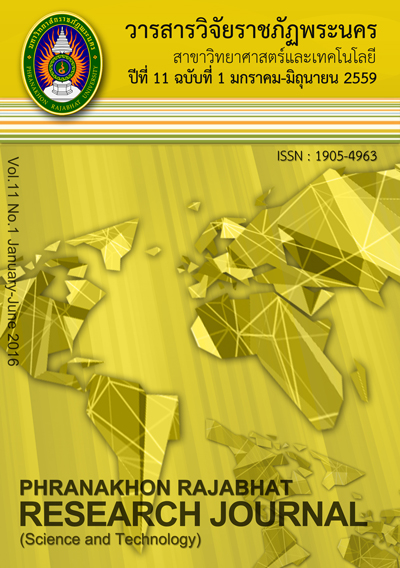การศึกษากำลังแบกทานของดินทรายจากผลการทดสอบการเจาะหยั่งแบบเบา
Keywords:
กำลังแบกทานของดินว, ดินทรายปนดินตะกอน, การทดสอบเจาะหยั่งแบบเบา, มุมองศาปลายกรวย, ระดับน้ำใต้ดิน, Bearing Capacity, Silty Sandy Soil, Kunzelstab Test, Apex Cone Angle, Water LevelAbstract
งานวิจัยนี้มีวัตถุประสงค์เพื่อศึกษากำลังแบกทานของดินทรายโดยใช้เครื่องมือทดสอบ การเจาะหยั่งแบบเบา โดยพิจารณาอิทธิพลของมุมองศาปลายกรวยและระดับน้ำใต้ดิน การศึกษาครั้งนี้ ใช้ตัวอย่างดินทรายปนตะกอน (SM) เป็นตัวแทนดินทราย การทดสอบได้จำลองให้ดินอยู่ในสภาพแห้งและมีระดับน้ำใต้ดิน จากผลการทดสอบการเจาะหยั่งแบบเบาพบว่า การเพิ่มขึ้นของมุมองศาปลายกรวยจะส่งผลให้จำนวนครั้งการตอกเพิ่มขึ้น โดยค่าปรับแก้จำนวนครั้งการตอกจากมุมองศาปลายกรวย 60 องศา เป็น 90 องศา และ 180 องศา เป็น 90 องศา มีค่าเท่ากับ 1.188 และ 0.878 (ค่าเฉลี่ยจากผลการทดสอบ) ตามลำดับ และเมื่อนำ ค่าจำนวนครั้งการตอกแปรผลเป็นค่ามุมเสียดทานภายในพบว่าสามารถใช้ได้ในระดับความลึกตั้งแต่ 0.6 เมตร เป็นต้นไป สำหรับอิทธิพลของระดับน้ำใต้ดินส่งผลให้ค่ากำลังแบกทานของดิน ลดลงร้อยละ 70 - 75 เมื่อเปรียบเทียบกับดินในสภาพแห้ง และมีผลต่อกำลังแบกทานของดินที่อยู่เหนือ ระดับน้ำใต้ดินขึ้นไปจนถึงระดับ 0.6 เมตร โดยลดลงเฉลี่ยร้อยละ 25 - 30 เมื่อเปรียบเทียบกับสภาพดินแห้ง ที่ความลึกเดียวกัน ดังนั้นการพิจารณาระดับฐานรากจึงควรคำนึงถึงผลกระทบของระดับน้ำใต้ดิน เพื่อให้เกิดความปลอดภัยในงานก่อสร้างมากยิ่งขึ้น
The objective of this research was to study the effect of the 3 apex angles of cone and the water levels on the bearing capacity of sandy soil layer by using kunzelstab test. The silty sandy soil (SM) was used as the representative of sandy soil. According to the results, the cone angle increase, a number of blows increase and the adjusted factors of the blows from the apex angles of 60º and 180º to be that of the apex angle of 90º (control) were 1.188 and 0.878 (average value from testing data), respectively. The correlation of the blows against the internal friction angles of SM soil can be used for calculating the soil bearing capacity under the condition that the depth was deeper than 1 m below the ground surface. The soil bearing capacity of SM soil below the water level decreases 70-75 percent comparing to dry soil. Moreover, the bearing capacity of SM soil above the water level up to 0.6 m decreases 25-30 percent comparing to that of the dry soil at the same depth. Therefore, the calculation of the soil bearing capacity in the silty sandy soil layer should be considered the effect of the water level.
Downloads
Published
Issue
Section
License
โปรดกรอกเอกสารและลงนาม "หนังสือรับรองให้ตีพิมพ์บทความในวารสารวิจัยมหาวิทยาลัยราชภัฏพระนคร สาขาวิทยาศาสตร์และเทคโนโลยี" ก่อนการตีพิมพ์




